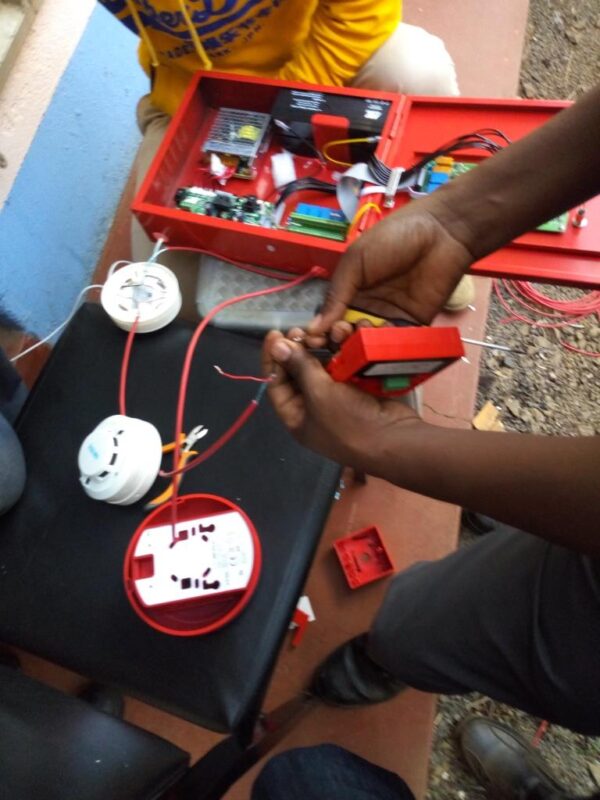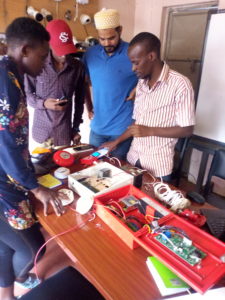LEARN THAT EXTRA SKILL. USE IT!!
Skills that sell . Results that are dependent on your effort.

Fire Detection, Suppression & Alarm System Installation Training – Nov, 2025

Synopsis
Security and fire alarm systems are often the first line of defense against property crime, potential fatalities, severe injuries, and crushing expenses. Those who install these systems must know and abide by their jurisdiction’s training, education, and certification requirements.
Kenvision Techniks Fire Alarm Installation course is aimed at individuals who want to pursue a career in the fire alarm industry as a fire alarm engineer, designer, fire alarm salesperson, and other fire alarm-related occupations.
Course Outline: Fire Detection, Suppression & Alarm System Installation Skills Training
Course Duration:
– Total Hours: 40–60 hours (Flexible based on delivery mode)
– Format: Classroom lectures, hands-on practical sessions, and assessments 
Course Objectives:
By the end of this course, participants will:
- Understand fire safety principles and regulations.
- Learn the components and operation of fire detection and alarm systems.
- Gain hands-on skills in installing, testing, and maintaining fire suppression systems.
- Interpret fire safety codes and standards (NFPA, OSHA, local regulations).
- Troubleshoot common issues in fire alarm and suppression systems.
Module 1: Introduction to Fire Safety Systems
– Importance of fire detection and suppression systems
– Types of fires (Classes A, B, C, D, K)
– Fire safety regulations and standards (NFPA 72, NFPA 10, local codes)
– Roles and responsibilities of fire system installers

Module 2: Fire Detection Systems
– Types of fire detectors:
– Smoke detectors (Ionization, Photoelectric, Air Sampling)
– Heat detectors (Fixed Temp, Rate-of-Rise)
– Flame detectors (IR, UV, Multi-Spectrum)
– Carbon Monoxide (CO) detectors
– Detector placement and spacing requirements
– Wiring and power supply considerations
Module 3: Fire Alarm Systems
– Components of a fire alarm system:
– Control panels (Conventional vs. Addressable)
– Notification devices (Horns, Strobes, Voice Evacuation)
– Manual pull stations
– Types of fire alarm systems:
– Conventional vs. Addressable systems
– Wireless fire alarm systems
– Alarm signalling (Local, Remote Monitoring, Central Station)
Module 4: Fire Suppression Systems
– Types of suppression systems:
– Water-based (Sprinklers, Deluge, Pre-action)
– Gas-b ased (CO₂, FM-200, Novec 1230)
ased (CO₂, FM-200, Novec 1230)
– Foam-based systems
– Dry chemical systems (ABC Powder, Wet Chemical for kitchens)
– Installation techniques for sprinklers and suppression agents
– System activation methods (Manual vs. Automatic)
Module 5: Installation & Wiring Practices
– Electrical safety and compliance
– Wiring methods (Class A, Class B circuits)
– Cable types and fire ratings
– Power supply requirements (Primary & Backup)
– Grounding and surge protection
Module 6: Testing, Commissioning & Maintenance
– Pre-installation checks and inspections
– Functional testing of detectors, alarms, and suppression systems
– Troubleshooting common faults
– Maintenance schedules and record-keeping
– Compliance certification and documentation
Module 7: Hands-On Practical Training
– Installation of smoke/heat detectors
– Wiring and configuring fire alarm panels
– Mounting and testing notification devices
– Simulating fire scenarios and system response
– Inspection and maintenance exercises

Module 8: Safety & Emergency Procedures
– Personal protective equipment (PPE) for installers
– Emergency response during system failures
– Evacuation procedures during fire incidents
– First aid and fire extinguisher training (Basic)
Assessment & Certification:
– Written Exam (Fire safety principles, codes, system design)
– Practical Exam (Installation, testing, troubleshooting)
– Certification: Participants receive a “Fire Detection & Suppression System Installer” certificate upon successful completion.
Who Should Attend?
– Electricians & technicians
– Fire safety professionals
– Building maintenance staff
– Security system installers
– Construction supervisors
Training Materials Provided:
– Training manuals & reference guides
– Installation toolkits (for hands-on sessions)
– Compliance checklists and templates

Course Objectives
During our Fire Alarm Installation course, you will learn a range of industrial fire alarm panels and associated components. You will learn how the devices fit into the system, how they function, and the way in which they should be configured, connected, and tested.
On-going assessments ensure that you are able to meet the objectives of the course.
At the successful completion of this course, the learner will be able to:
- Demonstrate the basic key concepts and all the components used in fire alarm systems.
- Install, test, and maintain conventional and addressable fire alarm systems.
- Recognize the role of fire alarm outputs and automatic and manual fire detectors.
- Describe the differences between fire alarm categories and grades.
- Explain the role of a fire alarm installer.
- Effectively work with other stakeholders in fire alarm installation.

Configuring Fire Alarm Control Panel
Who’s it for?
Anyone who
- needs knowledge of fire detection and alarm systems
- installs and tests hard-wired systems
- services/maintain fire alarm systems
Other experience/training needed to take the course
- None
Click on the following link to download the program:
https://www.kenvisiontechniks.com/cmdownloads/fire-detection-design-installation-testing-fire-alarm-maintenance/

